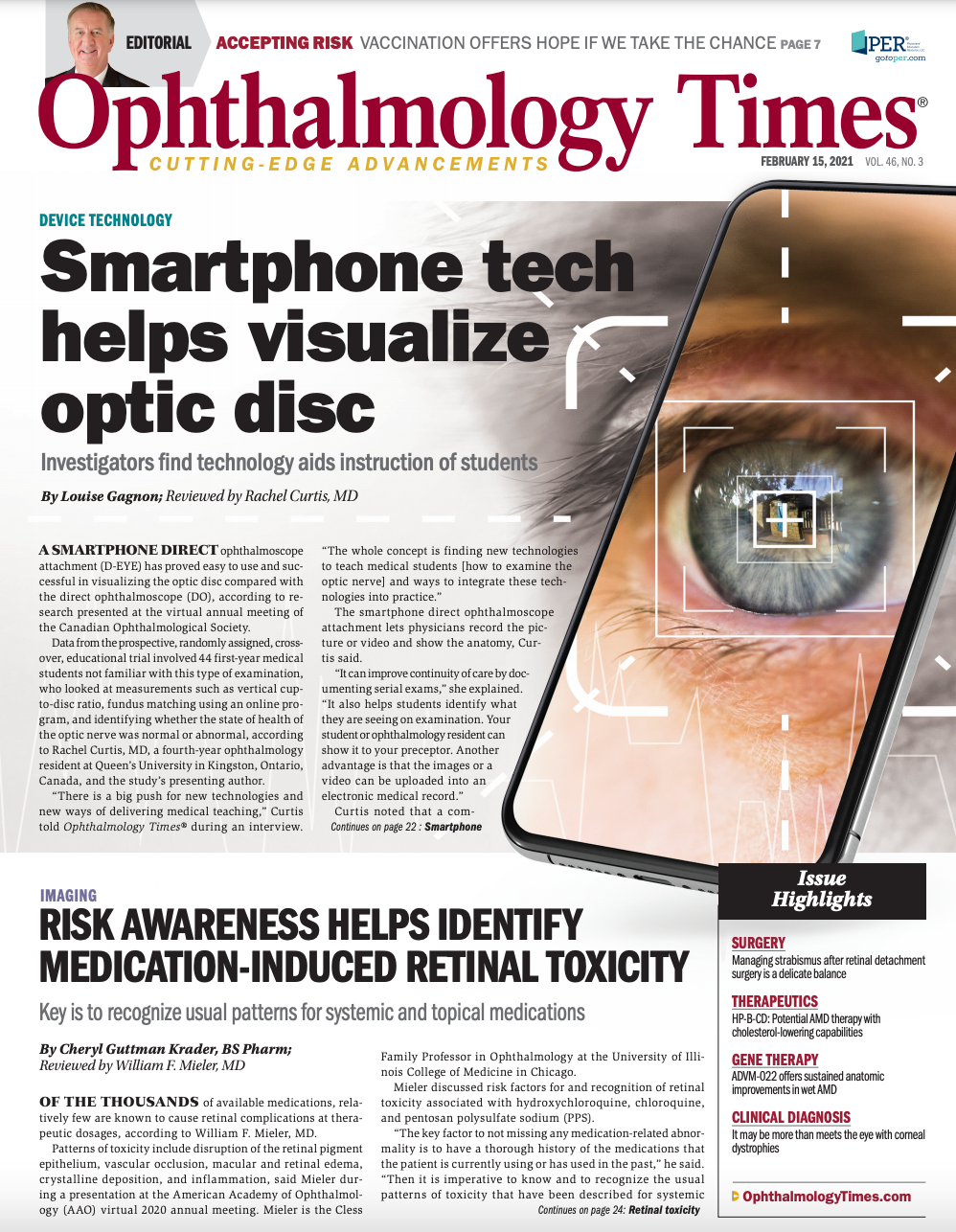Publication
Article
Digital Edition
Preferred practice patterns for bacterial keratitis address existing controversies
Author(s):
Ophthalmologists can opt to use vital stains for cultures and corneal scrapings.


This article was reviewed by Francis S. Mah, MD
Managing bacterial keratitis often is not a straightforward process. Several controversies surround its diagnosis and treatment, according to Francis S. Mah, MD.
Mah is the director of cornea and external disease and co-director of refractive surgery at the Scripps Clinic in La Jolla, California.
To culture or not to culture?
The current preferred practice recommendation for most cases of keratitis is empiric therapy without performing smears or cultures.
Related: Confocal microscopy key to diagnosing infectious keratitis
The cases that fall under this recommendation have a peripheral corneal ulcer smaller than 2 mm and no stromal melting, however, physicians can opt to culture with the use of vital stains for cultures and corneal scrapings.
Cultures and smears are needed in cases with a corneal infiltrate that is central; large; in the middle to deep stroma; chronic or unresponsive with atypical clinical features that suggest fungal, amoebic, or mycobacterial keratitis; and in patients with a vegetable trauma or who wore contacts while in a hot tub.
As Mah pointed out, culturing is important to identify the organism, determine antibiotic sensitivity, guide therapeutic modifications in unresponsive patients, decrease potential toxicity caused by unnecessary medications, and categorize microbial pathogens by examining stained smears of corneal scrapings.
Scanning laser confocal microscopy is useful in the diagnostic process to view the various corneal layers.
Related: Confocal microscopy: Seeing what does not meet the eyes
Recent advances in this technology facilitate enhanced resolution and microscopic power making it useful to diagnose infectious keratitis including bacterial, fungal, and especially parasitic organisms.
What about surgery?
A therapeutic keratoplasty is indicated in patients with progressive ulceration, extensive corneal involvement, the presence of a descemetocele, and perforation.
A keratoplasty is performed in 3% to 6% of all bacterial ulcers, with the most common pathogens being Staphylococcus and Pseudomonas species.
The microbial cure rates range from 90% to 100% and 69% to 100% have a clear graft at 1 year, Mah explained.
However, the timing of the surgery can be critical.
“A slight delay in the surgery improves the surgical outcome,” Mah pointed out.
Related: How surgeons can improve when using their nondominant hand
Antibiotic administration carries the hope of sterilization and corneal transplantation before further melting, perforation, or complications develop.
Monotherapy or combination therapy?
“There was always a question regarding use of commercial fluoroquinolones or fortified antibiotics from a compounding pharmacy,” Mah said.
Empiric therapy to treat bacterial keratitis with topical fluoroquinolones and/or fortified antibiotics, such as cefazolin, vancomycin, and tobramycin, can be considered, he said.
This approach includes a loading dose every 5 to 15 minutes for the first hour and then applications every 15 minutes to 1 hour around the clock.
“[Adherence to] this regimen is key,” he emphasized.
Mah said the preferred treatment in most cases is topical antibiotic eye drops, which can achieve high tissue levels. Application of ointments can be useful at bedtime for cases that are less severe, as well as an adjunctive therapy.
Topical broad-spectrum antibiotics are used initially in the empiric treatment of bacterial keratitis.
Related: Combination drops may help patients challenges by multiple glaucoma meds
For patients who have central or severe keratitis such as that extending into the deep stroma or when an infiltrate exceeds 2 mm with extensive suppuration, a loading dose as mentioned previously is needed and is followed by frequent instillations. With less severe keratitis, less frequent dosing is appropriate.
“I prefer dosing every 1 to 2 hours because of uncertainty about complete patient [adherence] and I want to have an edge in treatment during the first 24 to 48 hours,” he said.
Monotherapy with a fluoroquinolone is as effective as a fortified combination therapy with ciprofloxacin 0.3%, ofloxacin 0.3%, or levofloxacin 1.5%, all of which are approved to treat bacterial keratitis.
Mah pointed out that in in vitro studies, besifloxacin, gatifloxacin, and moxifloxacin have been shown to cover gram-positive pathogens better compared with the earlier-generation fluoroquinolones.
However, these drugs are not FDA-approved to treat bacterial keratitis, despite the results of randomized controlled trials that reported that moxifloxacin and gatifloxacin were equivalent to the combination of fortified cefazolin/tobramycin and possibly better than ciprofloxacin.
Related: Topical moxifloxacin: Best choice before cataract surgery?
Fluoroquinolone monotherapy to treat corneal perforation needs to be confirmed in future studies.
Mah recounted that some retrospective studies reported concerns about increased risk associated with monotherapy in patients with severe bacterial keratitis compared with use of fortified topical antibiotics, ie, cefazolin and tobramycin.
Combination therapy should be used to treat severe unresponsive infections, for nontuberculous mycobacteria, and for methicillin-resistant Staphylococcus aureus from a compounding pharmacy.
Systemic antibiotics, although rarely needed, can be used in severe cases of keratitis in which the infection has entered adjacent tissues, for impending or frank perforation, and for gonococcal keratitis.
Adjunctive keratitis treatments
These treatments include cycloplegic agents and a collagen shield or bandage contact lens to increase the antibiotic concentration.
A bandage contact lens also can be considered for stromal melting as well as vitamin C, topical medroxydrogesterone, topical N-acetylcysteine, and oral tetracycline.
Related: Drug delivery contact lens technology
Crosslinking for infectious keratitis may be beneficial for treating moderate bacterial keratitis. “The procedure accelerates epithelialization, shortens the treatment course, and minimizes or negates the need for surgery and other serious complications such as perforation,” Mah explained.
The use of steroids in keratitis is controversial and remains inconclusive, in that no increased risk of adverse events has been found, and steroids may improve outcomes with large central ulcers and severely decreased visual acuity. No benefit has been seen in Nocardia keratitis.
According to Mah, the take-home message regarding keratitis therapy is to culture if the lesion is large, serious, or unusual; administer sufficient medication in a timely manner; carefully monitor therapeutic and adverse effects; and consider referral of Descemet’s anterior lamellar keratoplasty or penetrating keratoplasty early, but not too early.
Francis S. Mah, MD
e:Mah.Francis@scrippshealth.org
Mah is a consultant to Alcon, Allergan, Bausch + Lomb, Novartis, Kala, EyeVance, and Glaukos.

Newsletter
Don’t miss out—get Ophthalmology Times updates on the latest clinical advancements and expert interviews, straight to your inbox.




